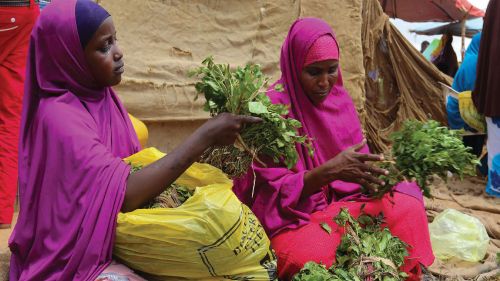Hungry for Equality: Examining the Gender Gap in Food Security

Women and girls make up 60 percent of the world's chronically hungry population and are 10 percent more likely than men to experience food insecurity.
Introduction
Ten years ago, the UN World Food Program found that women and girls made up 60 percent of the world’s chronically hungry population. In the decade since, many organizations explicitly included gender in their food and agriculture strategies. Multiple UN agencies adopted policies on gender equality beginning in 2009. Feed the Future, launched in 2009 by USAID, emphasizes gender equality. The Chicago Council released its 2011 report Girls Grow: A Vital Force in Rural Economies, urging the development community to focus on rural adolescent girls and offering recommendations on how to do so. Despite these commendable efforts, women remain especially susceptible to food insecurity. In fact, the 2019 State of Food Security and Nutrition in the World from the Food and Agricultural Organization of the United Nations reported that women are ten percent more likely than men to experience food insecurity, and globally more women are food insecure than men. What is driving women’s different experiences of food security, and why is the food security gender gap so persistent?
What Contributes to Women's Food Insecurity?
A recent study found that although household income, social networks, and educational attainment are major factors in food insecurity overall, they cannot fully account for women’s higher rates of food insecurity. Land rights and social norms are major contributors to women’s food insecurity. Women generally have less access to land and agricultural inputs than men, and often face unequal-decision making power in the home.
Only 12.8 percent of global landholders are women. In many countries, traditional practice is for women to eat last, after the men and children in their families. Although this practice is changing, it still contributes to malnourishment and anemia in women. When households’ access to food becomes precarious, women often adapt by eating less so that the rest of their family can have more. As long as women bear the brunt of food crises, they will experience higher rates of food insecurity. As long as women experience higher rates of food insecurity, there will be a need for gender-responsive aid.
Gender-Responsive Aid Faces Many Challenges
Additional time in program design, increased time burdens for women, and a lack of data to work from are all challenges for gender-responsive aid, among others. Consultative development of projects takes time. Understanding local gendered context requires qualitative and quantitative research. Designing programs around this understanding requires thoughtful planning and a willingness to adapt and change in the middle of implementation.
Even when implemented with a gender-responsive plan, a project may appear to only have small economic effects for the women who participate, which can make it hard for implementers to justify the additional cost in project design. A program to improve smallholders’ dairy-related incomes in Bangladesh revealed that participation in gender-responsive projects may have small, statistically insignificant benefits (for example, increases in asset ownership) for women. That does not, however, suggest that the approach should be abandoned. Rather, it indicates that in areas with deeply entrenched gender norms, progress happens incrementally.
Another challenge relates to existing, competing demands on women’s time. Women face the dual burden of agricultural and household work, which create competing demands on their time. Over one quarter of women participating in an agricultural project in Burkina Faso cited the time commitment of participation as a cost, as it took time away from time spent on household tasks such as cooking and collecting wood. Like the gendered effects of food insecurity, when projects require an increase in daily labor, far too often most of that increase is borne by women.
Each of these issues is exacerbated by the lack of necessary gender data. Few programs disaggregate project data by gender, making it harder to track whether a project benefits women and girls. Most countries lack measurement of the differences between the participation of men and women in local and civil society organizations—information crucial to structuring effective agricultural interventions. While the UN Statistics division has made progress in establishing consistent methodologies for progress indicators for Sustainable Development Goal 5 (achieve gender equality and empower all women and girls), consistent collection remains a problem. Without good data, women and girls’ food security will be difficult to measure or improve.
More Gender-Responsive Development is Needed
Supporting, empowering, and ensuring that women have equal access to food and the resources necessary for them and their families to succeed requires more than adding them into a program’s mission statement. It requires a commitment to investing in projects that are designed with women and their needs in mind.
Despite a decade of gender-supportive rhetoric, gender development goals need increased funding. In 2018, the OECD’s Development Assistance Committee (DAC) examined Official Development Assistance (ODA) committed by DAC members in 2015-2016. Their analysis focused on economic and productive sectors, which includes agricultural and rural development. Of the bilateral, allocable aid analyzed, only one percent included gender equality as the primary objective, which was a decline from 2013-2014. 66 percent of aid examined did not target gender equality at all.
Even when a project is intended to benefit women, it can fall short if it fails to be human-centered in its design. For example, one study of a clean cook stove initiative in India found that because improved cookstoves did not provide direct benefits to their lives, men who were heads of households were less likely to spend money on them. Understanding household decision-making is a key component to improving the lives of women.
An understanding of the community decision-making and leadership context is also important to craft development aid that is effective in promoting gender equality. Even in cases where organizations and governments work with community leaders to design and implement projects, women are often excluded. As noted by Catherine Bertini in her article "Invisible Women," a lack of women in leadership roles leads policy- and grant-makers to respond to the needs of men, mistaking them for the needs of the whole community.
Other studies reinforce the need for contextually sensitive agricultural aid. An evaluation of four projects promoting high-value commodities and value chain development for smallholder farmers found that “gendered use, control, and ownership of assets affect who can participate in agricultural development projects.” If men control most of a household’s assets, they are more likely to participate in an agricultural project than the women in their household. Men’s participation in a project, in the absence of a concerted effort to alter benefit distribution, virtually guarantees that men will receive most of the benefits of the project. Even when women in a household participate in a project, men often end up in control of the additional income the women generate.
Empowering Women in Agriculture will Feed the World
More funding and political support is needed to make gender-responsive development standard, rather than exceptional. This should be accompanied by wide-scale efforts to collect data that are disaggregated by gender. Human-centered agricultural development projects designed around women’s needs and experiences can make tangible differences in the lives of women and their families. When women are provided with the same inputs, assets, and technical assistance as men, their yields could increase by as much as 20-30 percent, which translates to a reduction in the number of undernourished people in the world by 12-17 percent. Additionally, evidence shows that when women’s income increases, so do household expenditures on education and nutrition. Empowering women will not only reduce women’s food insecurity, but also boost global food security and economic prosperity for everyone, men and women alike. The global community must devote significant resources to empowering women and girls—as we face a global population of almost 10 billion by 2050, we simply can’t afford not to.

